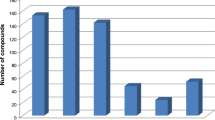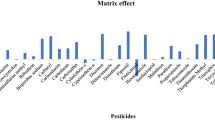Abstract
A sensitive and specific liquid chromatography/tandem mass spectrometry (LC/MS/MS) method was developed for the determination of 56 residual pesticides from commercial crops. For a validation of the method, the recoveries, linearities, limits of detection (LOD), and limits of quantitation (LOQ) of the 56 pesticides were investigated. The linearities, LOD, and mean recoveries of the pesticides ranged 0.9686–0.9999, 0.00–11.54 μg/kg, and 65–82%, respectively. This method was evaluated by its application to monitor 345 agricultural products collected from 9 provinces in Korea 2011. Fifteen pesticides were detected from 39 samples and 2 or more residual pesticides were found in 7 samples. However, none of the compounds were observed above the corresponding maximum residue level. The results reflect that the detected pesticide residues were in a safe range and that residual pesticides in the agricultural products in Korea were properly controlled.
Similar content being viewed by others
References
Cus F, Cesnik HB, Bolta SVS, Gregorcic A. Pesticide residues in rapes and during vinification process. Food Control 21: 1512–1518 (2010)
Dunovska L, Cajka T, Hajslova J, Holadova K. Direct determination of acrylamide in food by gas chromatography-high-resolution timeofflight mass spectrometry. Anal. Chim. Acta 578: 234–240 (2006)
Hajslova J, Zrostlikova Z. Matrix effects in (ultra) trace analysis of pesticide in food and biotic matrices. J. Chromatogr. A 1000: 181–197 (2003)
Hernando MD, Suarez-Barcena JM, Bueno MJM, Garcia-Reyes JF, Ferenandez-Alba AR. Fast separation liquid chromatographytandem mass spectrometry for the confirmation and quantitative analysis of avermectin residues in food. J. Chromatogr. A 1155: 62–73 (2007)
Lehotay SJ, Kok AD, Hiemstra M, Bodegraven PV. Validation of a fast method for the determination of residues from 229 pesticides in fruits and vegetables using gas and liquid chromatography and mass spectrometric detection. J. AOAC Int. 88: 595–614 (2005)
Mastovska K, Lehotay SJ, Anastassiades M. Combination of analyte protectants to overcome matrix effects in routine GC analysis of pesticide residues in food matrixes. Anal. Chem. 77: 8129–8137 (2005)
Eenoo PV, Delbeke FT. Criteria in chromatography and mass spectrometry-A comparison between regulations in the field of residue and doping analysis. Chromatographia 59: S39–S34 (2004)
Azucena G, Tiaziana M. The demand for organic foods in the south of Italy: A discrete choice model. Food Policy 33: 386–396 (2008)
Korea Food & Drug Administration (KFDA). Testing Method for Food. Food Code 2011. KFDA, Chungbuk, Korea. pp. 10-4-10–10-4-17 (2011)
Fang G, Chen W, Yao Y, Wang J, Qin J, Wang S. Multi-residue determination of organophosphorus and organochlorine pesticides in environmental samples using solid-phase extraction with cigarette filter followed by gas chromatography-mass spectrometry. J. Sep. Sci. 35: 534–540 (2012)
Steinjger D, Lu G, Butler J, Phillips E, Fintschenko Y. Determination of multiresidue pesticides in green tea by using a modified QuChERS extraction and iom-trap gas chromatography/mass. J. AOAC Int. 93: 1169–1179 (2010)
Korea Food & Drug Administration (KFDA). Food Safety Management Guidelines 2011. KFDA, Chungbuk, Korea (2011)
Korea Centers for Disease Control and Prevention (KCDC). Korea Health Statistics 2010. Korea Health and Nutrition Examination Survey (KNHANESV-1). Available from: http://knhanes.cdc.go.kr. Accessed May 22, 2013.
Korean Statistical Information Service (KOSIS). Census 2010. Available from: http://kosis.kr/abroad/abroad_01List.jsp. Accessed May 22, 2013.
Kim BJ, Myung SW. Effect analysis of dicyclanil in lamb and chicken muscle using HPLC-UV/VIS and LC/MS/MS. Mass Spectrom. Lett. 2: 45–48 (2011)
Shrivastava A, Gupta VB. Methods for the determination of limit of detection and limit of quantitation of the analytical methods. Chron. Young Sci. 2: 21–25 (2012)
Akiyama Y, Matsuoka T. Application of multi-residue analytical method for 12 pesticides added to the positive list. Research Report of Public Health Science Research Center in Hyogo Prefectural Institute of Public Health and Consumer Sciences 1: 38–42 (2010)
Edison SE, Lin LA, Gamble BM, Wong J, Zhang K. Surface swabbing technique for the rapid screening for pesticides using ambient pressure desorption ionization with high-resolution mass spectrometry. Rapid Commun. Mass Sp. 25: 127–139 (2010)
Sinha SN, Rao VVM, Vasudev K, Odetokun M. A liquid chromatography mass spectrometry-based method to measure organophosphorous insecticide, herbicide, and non-organophosphorous pesticide in grape and apple samples. Food Control 25: 636–646 (2012)
European Food Safety Authority (EFSA). Setting of new MRLs for amisulbrom in wine and table grapes. EFSA J. 7: 1349 (2009)
Huang B, Han Z, Cai Z, Wu Y, Ren Y. Simultaneous determination of aflatoxins B1, B2, G1, G2, M1, and M2 in peanuts and their derivative products by ultra-high-performance liquid chromatographytandem mass spectrometry. Anal. Chim. Acta 662: 62–68 (2010)
Huang Z, Zhang Y, Wang L, Yan H, Li Y, Zhu S. Simultaneous determination of 103 pesticide residues in tea samples by LC-MS/MS. J. Sep. Sci. 32: 1294–1301 (2009)
Yu K, Krol J, Balogh M. A fully automated LC/MS method development and quantification protocol targeting 52 carbamates, thiocarbamates, and phenylureas. Anal. Chem. 75: 4103–4112 (2003)
LeDoux M. Analytical methods applied to the determination of pesticide residues in food of animal origin. A review of the past two decades. J. Chromatogr. A 1218: 1021–1306 (2011)
Zou P, Ding W, Tong W, Ghosal A, Alton K. Chowdhury S. A retention-time-shift-tolerant background subtraction and noise reduction algorithm (Bgs-NoRA) for extraction of drug metabolites in liquid chromatography/mass spectrometry data from biological matrices. Rapid Commun. Mass Sp. 2: 1563–1572 (2009)
Author information
Authors and Affiliations
Corresponding author
Rights and permissions
About this article
Cite this article
Lee, Hm., Park, SS., Lim, M.S. et al. Multiresidue analysis of pesticides in agricultural products by a liquid chromatography/tandem mass spectrometry based method. Food Sci Biotechnol 22, 1–12 (2013). https://doi.org/10.1007/s10068-013-0203-9
Received:
Revised:
Accepted:
Published:
Issue Date:
DOI: https://doi.org/10.1007/s10068-013-0203-9




